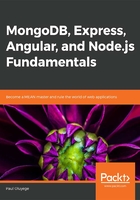
Summary
In this chapter, we first described MEAN architecture by briefly expanding on the layers that comprise the MEAN stack: MongoDB, Express, Angular, and Node. For each of these components, we discussed their features/advantages and limitations. Thereafter, we began by describing the Node framework in detail. We first discussed the various installation options (the LTS or stable versions) that are available. Then, we had a brief look into the built-in modules that make up Node and also learned about the steps that are involved in starting a Node application.
In the succeeding topics, we described some important concepts in Node such as callbacks, event loops, event emitters, buffers, streams, and the filesystem. For callbacks, we described its implementation in synchronous and asynchronous mode. We also looked into how Node employs event loops in sequencing program operations. Next, we learned how to add event listeners, trigger events, remove listeners, and implement some other features. We then progressed to discussing buffers. Specifically, we learned how to create, read, and write into buffers.
The next topic described various types of streams that are available. We performed an exercise on writing to and reading from a stream. Finally, we discussed the filesystem and implemented different operations that can be performed on a file via an activity.
In the next chapter, we will begin developing RESTful APIs to perform create, read, update, and delete (CRUD) operations.